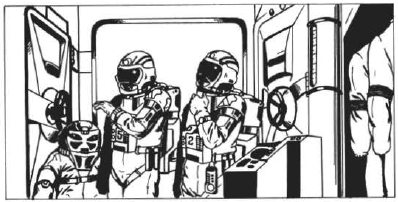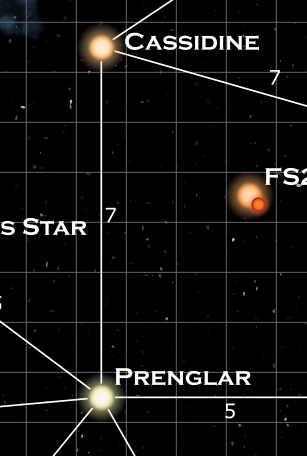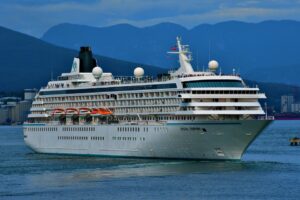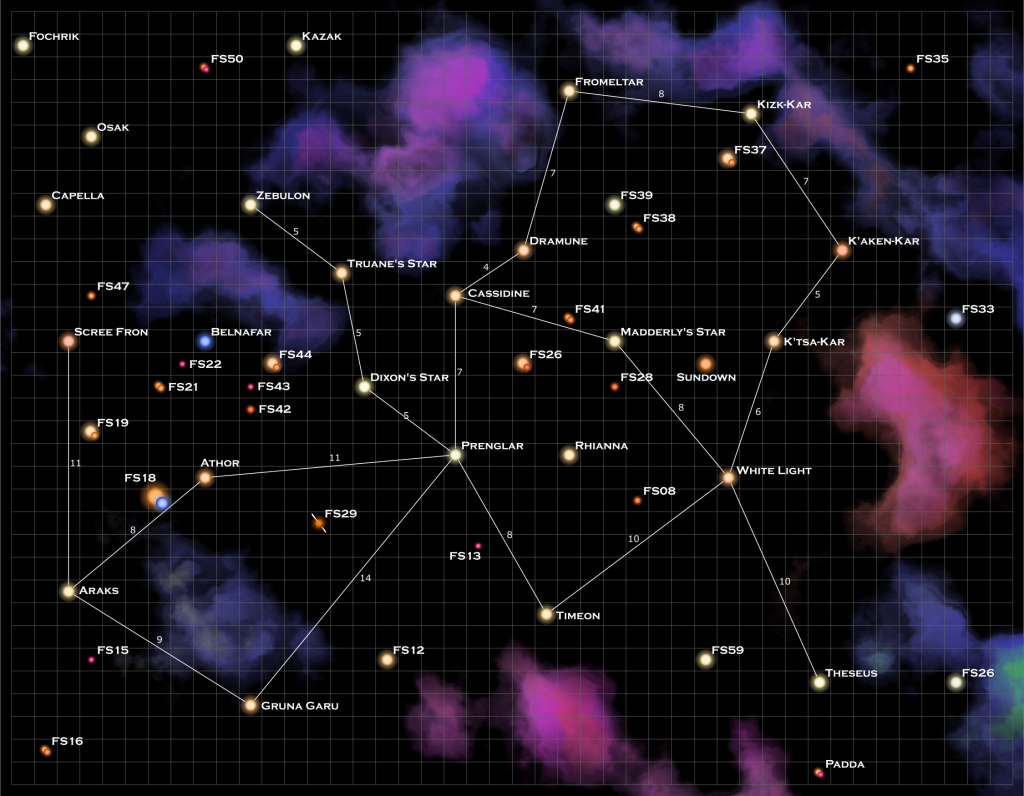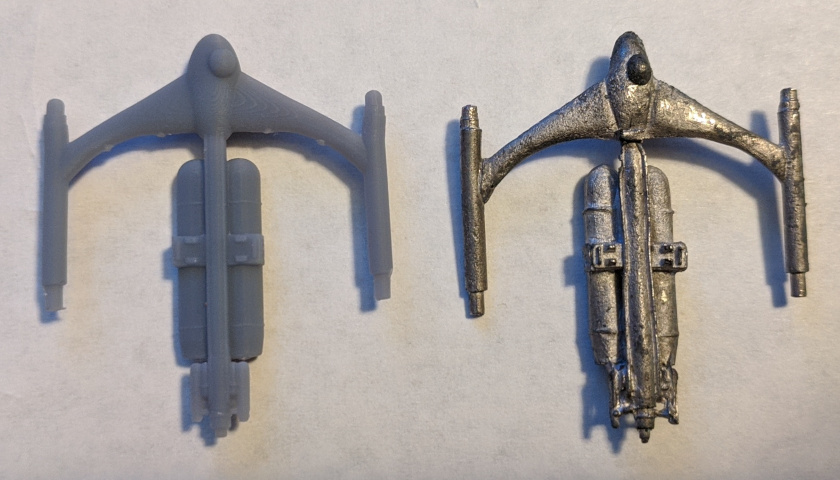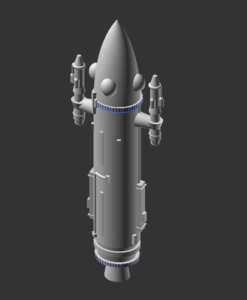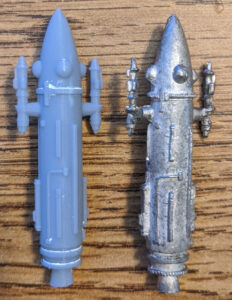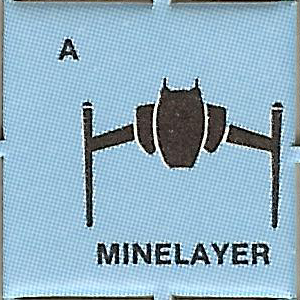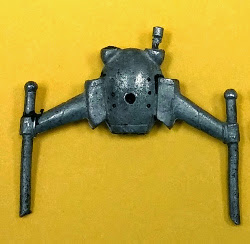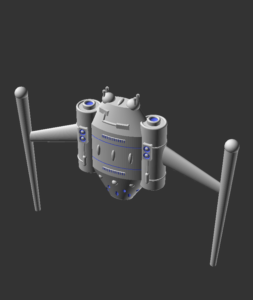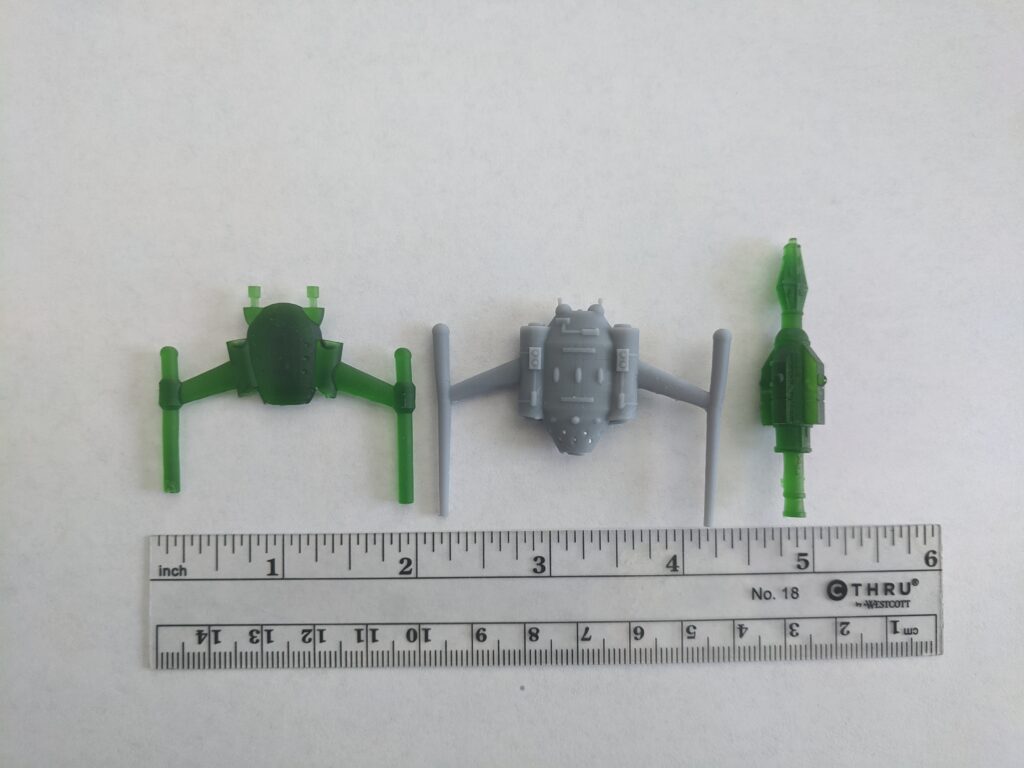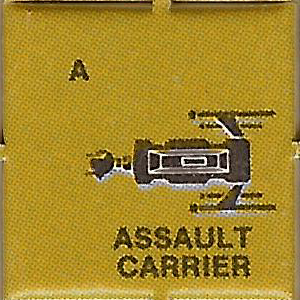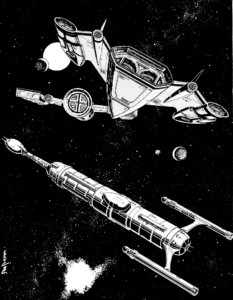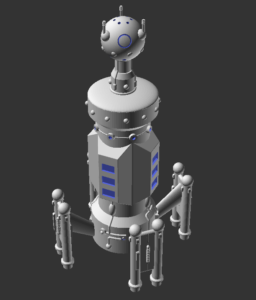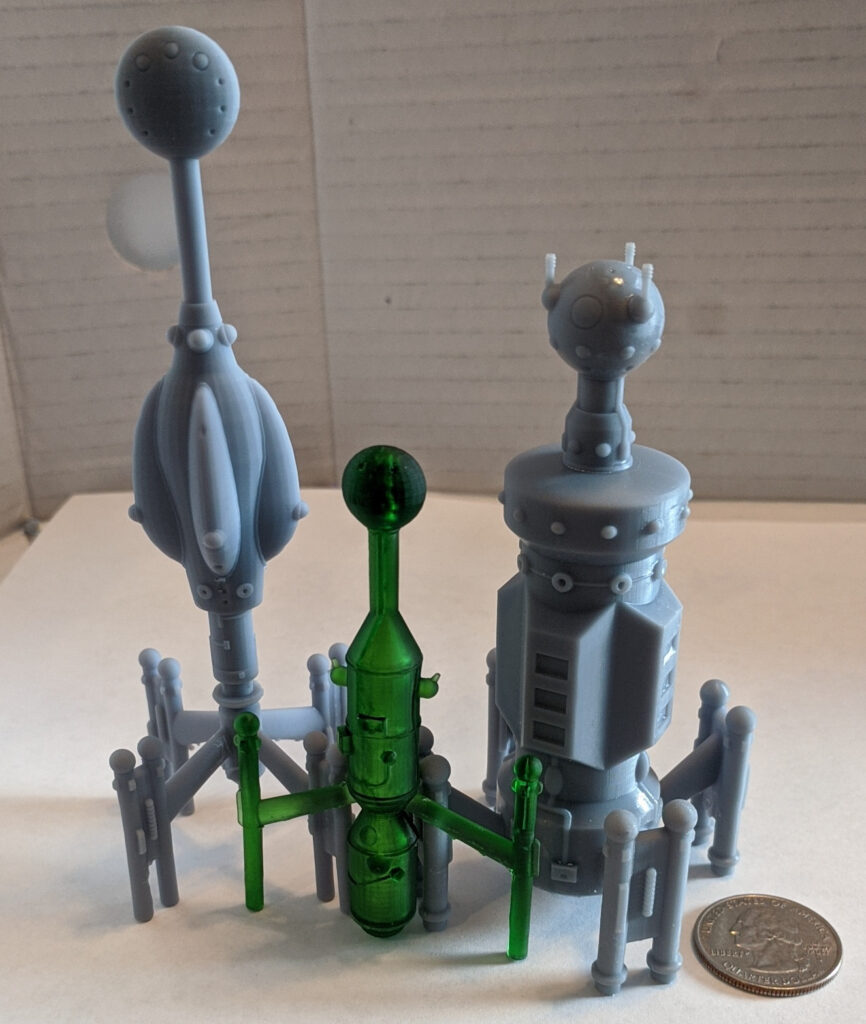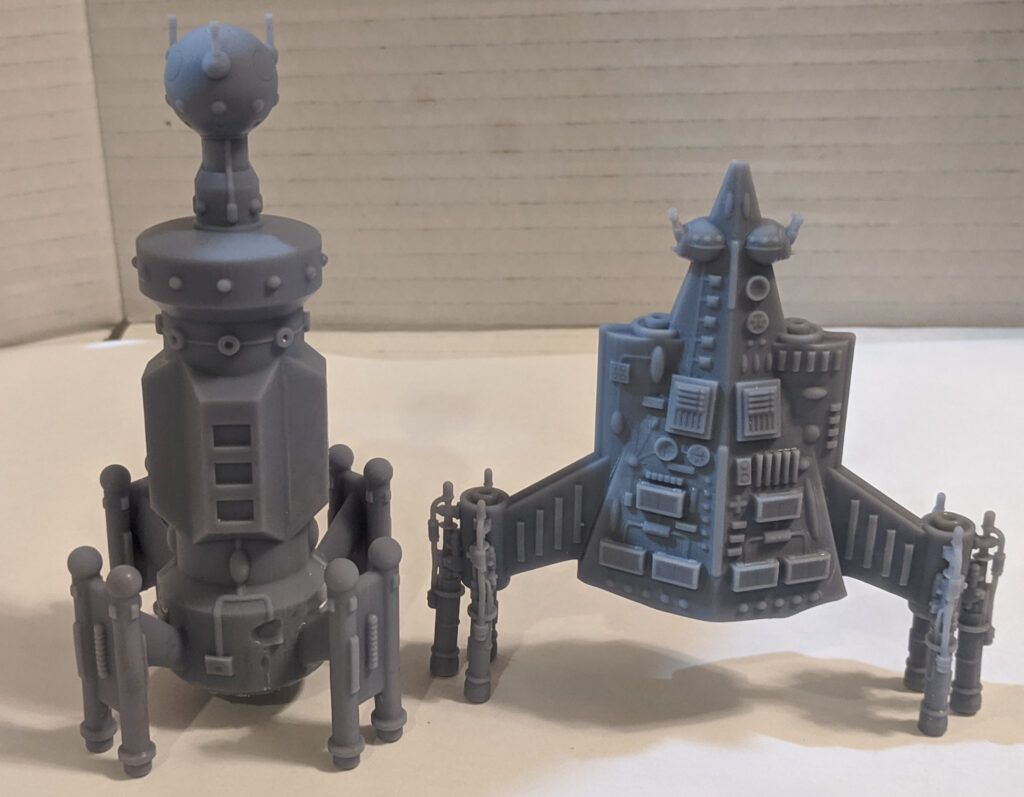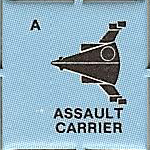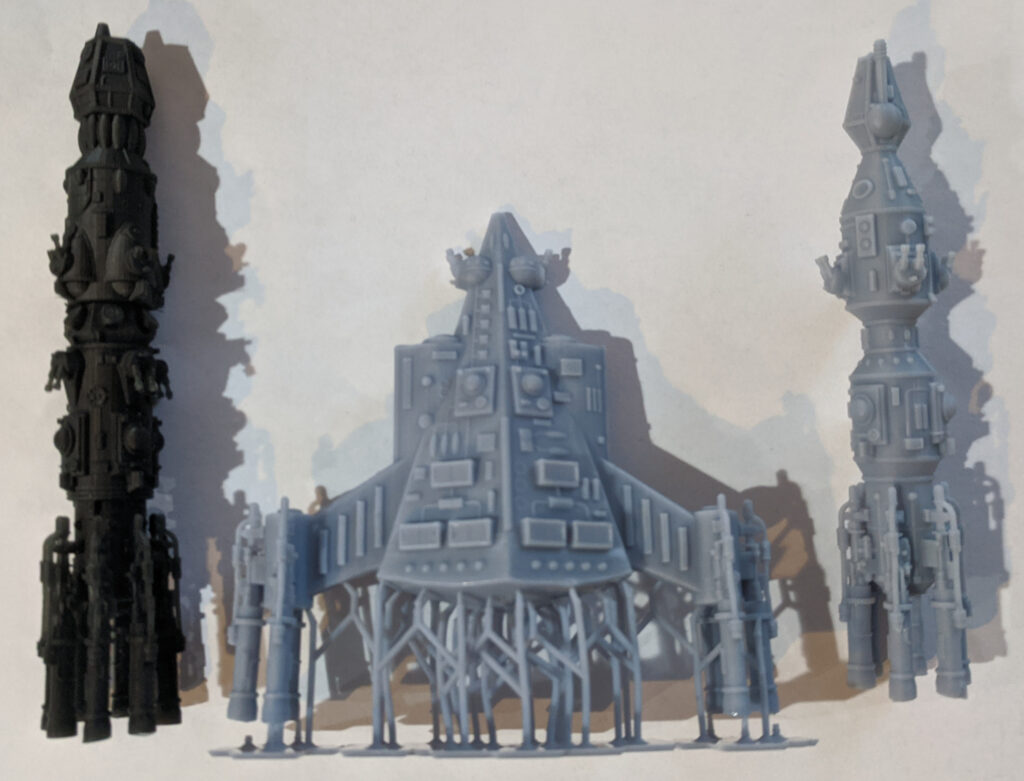This isn’t the post I had planned to do this week but since my game session last Wednesday fell through, I can’t post the details of that adventure yet. So I’m going to revisit the HSS History’s Hope this week. Hopefully we’ll get that game session in on Wednesday and I can post up all the goodies from that adventure.
A few weeks back I was contacted by long time game fan Matt Crymble about the HSS History’s Hope and the timeline project in general. Matt’s on-line involvement in Star Frontiers predates even my one as he is one of the original list serv members from back in the day that I was never a part of. We featured some of Matt’s creations in early issues of the Frontier Explorer and he created the Khad’dan, or yazirian honor blade that figures into a lot of the fan material.
He asked me if I was interested in any help on creating the ship and while I already had KH stats and partial deck plans for the ship, he did a wonderful write-up on the ship’s history. So let’s look at the ship a bit closer.
The HSS History’s Hope
History of History’s Hope
This is the write-up Matt sent me:
The HSS History’s Hope began life as an Imp Class Yacht which was modified into a racing yacht. The vessel class was initially selected for reliability and comfortable long term crew habitation, both critical for the exhausting pace of multi-system racing. Its speed was boosted at the expense of some maneuverability and as a racer it held a distinguished career even though it was not considered a champion. Unfortunately, the highly competitive nature of interstellar racing meant that the ship was too expensive to maintain without champion results and it was eventually made available for sale.
The vessel’s reliability and comfortable crew accommodations also made it a good choice as an exploration vessel and the extra bracing that was added for the increased acceleration from a standard Imp Class make it a sturdy little ship. The racer was slightly modified again after being clandestinely purchased by True Yazira and was rechristened the HSS (Histran Star Ship) History’s Hope out of the Scree Fron system.
Little modification was needed to turn the vessel into an exploration ship, though extra food and fuel stores as well as crew comforts and spare parts were added. Additionally the ship’s precision racing navigation station, known as the “sailing bridge” aboard ship, remains unchanged physically having only received new software to assist with the difficult astrogation tasks of plotting entirely new jump routes.
Because of its status as an exploration vessel the standard radar system was upgraded to include a planetary radar mapper and a planetary scanning system. The planetary scanning system can also work as a limited energy sensor in a focused area in an emergency while in interstellar space. The History’s Hope retains the ability to land on atmospheric worlds with habitable G ratings. The Assault Rocket launcher has been removed though a small part of the mechanism remains and parts were later added to give the vessel the ability to launch atmoprobes.
Crew compliment for a ship this size is small. This is a holdover from its racing days when extra crew was considered extraneous and the vessel is usually crewed with experienced spacers to ensure all needed skills are present. The extra crew berths are taken up by scientists and other specialists with most of the remainder being used for the extra storage necessary for such a long journey.
I hadn’t thought of the idea of an old racing ship, but I had intended it to be HS 4 and an old yacht. So I love this backstory for the ship. There are just a few things in his write-up that I am going to change. Otherwise, it will stand as is.
Modifications
First, it wasn’t “clandestinely purchased by True Yazira.” At least not explicitly. The ship is owned by the Yazira Heritage Foundation (YHF) which is a public non-profit organization. The True Yazira society is a major funder of the YHF, but not as an organizational endeavor. Rather the YHF has many private donors who also happen to be True Yazira members. It’s a happy coincidence. Although not surprising as the goals of the YHF directly align with some of the goals of the True Yazira society and it’s only natural that members of one would donate to the other.
Second, the ship was modified to have a lot more crew that I think Matt was intending. In the end, the ship has a total crew capacity of 24. Actually, there are 24 crew members, the capacity is actually a bit higher but that would require double bunking.
In addition to the ability to launch atmoprobes, I also added in a landing drone and a remote probe, as well as adding in a full-sized (20 being) lifeboat, a small (10-person) lifeboat, a workpod, and small launch. The truth is, a HS 4 ship starting to be pretty large. Designing the ship with my new starship construction system that takes volume into account, and adding in all the systems I needed, created a ship that was within a couple hundred cubic meters of the standard HS4 volume, a difference of just a few percent which is well within the design variation limits given in the rules.
I like how he indicated that it probably had a Deluxe Astrogation suite. That was definitely in the cards for this ship and it would have been upgraded to such if it didn’t already have it. In my game, having the Deluxe Astrogation suite gives a +10% to all astrogation skills. Something definitely needed when charting unknown routes.
While the planetary radar mapper and a planetary scanning system are not standard equipment listed in the rules, I like the description. I did add energy sensors to the ship, so that have that at full capablitily, not just a limited one as described in Matt’s text.
Full Ship’s Stats
Here are the full stats for the ship as I wrote it up:
| HS: | 4 |
| ADF: | 4 |
| MR: | 3 |
| DCR: | 32 |
| Engines: | 2x Class A Atomic |
| Crew Berths: | 24 single occupancy cabins – Journey Class equivalent |
| Weapons: | LB |
| Defenses: | RH |
| Communications Equipment: | videocom radio, subspace radio, Intercom system |
| Sensor Systems: | deluxe astrogation suite, radar, energy sensors, skin sensors, external camera system |
| Life Support: | Primary: 600 days for 35 beings Backup: 200 days for 35 beings |
| Exploration Equipment: | 2x atmoprobe, 1x remote probe, 1x landing drone, 1x laboratory |
| Computer Level: | 4 |
| Computer Programs: | Astrogation 4, Atomic Drives 4, Computer Lockout 4, Damage Control 2, Alarm 2, Laser Battery 1, Skin Sensors 1, Guidance/Analysis 3, Anlysis 3, Maintenance 1, Information Storage 6, Communications 3, Language 4, Robot Management 4 |
| Vehicles: | small launch, large lifeboat, small lifeboat, workpod |
| Other Equipment: | 30 spacesuits, laser power torch, 2x engineer’s toolkit, full redundant backup computer, 300 atomic fuel pellets |
Deck plans will come in a future post. I have them mostly sketched out but still have a couple decks to go and need to make digital versions of them to share.
The Journey So Far
That’s the ship. Let’s next turn to looking at the crew and their travels up until now.
Crew
The crew is fairly large for this small of a ship, but the truth is, there is plenty of room inside the hull for them all. The crew size, as given in the stat block above, is twenty-four. It breaks down like this:
- 2 pilots
- 3 astrogators, one of which is the captain of the expedition
- 2 engineers
- 2 energy weapons specialists
- 2 technicians
- 1 roboticist
- 1 computer specialist (in addition to the astrogators)
- 1 psycho-social specialist
- 1 doctor
- 2 environmentalists
- 4 security personnel
- 1 linguist
- 2 archeologists
The first half of the crew are concerned with getting them to their destination or keeping the ship systems and crew running on the journey. The second half are merely passengers for the initial voyage, their skills will be needed if their destination turns out to actually be Yazira.
The Journey
When I first posted about the trip, the ship had left the Frontier and started into the Yazira sector and had made several misjumps. In the intervening months, they have recovered from those early errors, made more, recovered again, and continue to make progress toward their goal. Here is the sector map with the systems they have visited and the jump routes plotted.

The route to YS07 is a bit of a spoiler, but only because I’m a bit behind on posting the timeline updates. I should have already posted the successful jump from YS06 to YS07 by now. In fact, today they are beginning their acceleration back to YS06. Those updates will show up in the next few days. At this point, they are about 1/3 of the way across the Yazira Sector to their destination and not quite half way from Scree Fron.
What Does the Future Hold?
The ship is coming up on its one year anniversary since it’s retrofit. That means that they will have to decide if they want to double back to the Frontier for their annual maintenance, or skip it this first year and push on. Even making a high speed transit, it’s on the order of 50 days back to Scree Fron and another week to the nearest SCC. Then 5-15 days of maintenance. And then that same amount of travel time to get back to where they left off. That’s over a quarter of a year of travel. They’ll have to decide if the chance of a system breakdown is worth it.
Also, they were attacked back in YS01. There may still be ships there. And most probably there will be hostile ships in the Frontier itself. They have enough fuel and life support to make it all the way to their destination assuming no major mishaps. But they may have to return for supplies anyway.
The next jump after YS07 is going to be a long one, either 10 or 12 light years. And then some long ones after that, so there is plenty of chance for mishap. There’s a reason this part of space is called the Vast Expanse, the stars are few and far between and the crew is starting to run into that now.
I know what the future holds for the ship in certain areas, but I am actually rolling for all the astrogation skill checks as they come up so I never know if they will succeed in a jump or not. Which means I don’t know how successful they will be or what detours will come up. We’ll have to find out together.
Final Thoughts
That’s it for this post. I’m working on the deck plans and will post them, along with another progress update, once they are done. I’m also planning on a 3D model of the ship once the deck plans are finished. Although that might not be for a couple more months. But those are things you can look forward to.
What thoughts to you have on the travels of the HSS History’s Hope? Are there things about the ship or the expedition you’d like to know more about? Do you have ideas of things they might run into? Let me know in the comments below.

